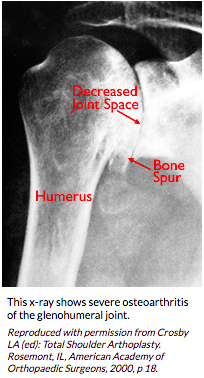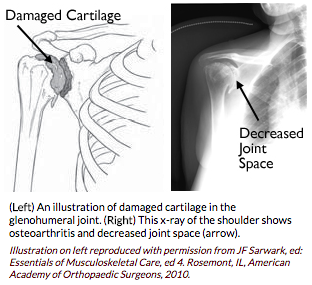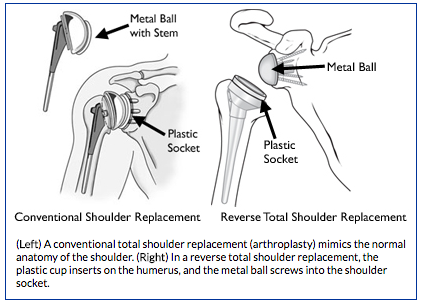Shoulder Arthritis

I want to discuss a condition that I frequently diagnose and treat in my clinic and for which I have a particular fondness and focus within my orthopedic surgery practice, shoulder arthritis. I have many patients who come to see me with shoulder pain who are a) very surprised to find out that they have shoulder arthritis and b.) are even more surprised to find out that there are excellent treatment options available to treat shoulder arthritis.
The shoulder joint (termed the “glenohumeral joint” in medical nomenclature) is the third-most common large joint affected by degenerative joint disease (knee and hip arthritis are more common). There are multiple types of shoulder arthritis and all of these ulitmately result in a wearing away of the “cushion” of the joint, the smooth outer covering of the bone known as the articular cartilage. As the cartilage wears away, the protective space within the shoulder joint narrows and the cartilage becomes rough and frayed and eventually wears completely away. This results in the bones of the shoulder joint rubbing against each other, causing pain. Because of the increased pressure on the surfaces of the bone, there can be structural changes that gradually occur within the shoulder including the formation of bone spurs (termed “osteophytes”) and changes of the shape of bones of the shoulder. Although there is no cure for shoulder arthritis, there are many treatment options available. The goals for treatment are to manage pain and to allow you to remain active.
Pain is the most common symptom of arthritis of the shoulder and it is exacerbated by activity. The natural progression is for the pain to worsen over time, although how rapidly the pain progresses is unique to each patient. With shoulder arthritis, the pain is typically centered deep within the shoulder and may intensify with weather changes. Patients typically describe their pain as a deep ache, which worsens with activity.
Other symptoms include limited range of motion, sensations of clicking, grinding, and or snapping with movement of the shoulder, and, as the disease process progresses, pain at night which causes significant difficulty with sleep.
Initial treatment of shoulder arthritis is nonsurgical and includes options such as:
Rest or change in activities to avoid exacerbating the pain. This also includes changing how you move your shoulder to accomplish specific tasks to minimize discomfort Physical therapy to maximize range of motionNonsteroidal anti-inflammatory medications (NSAIDS) to reduce pain and inflammation, . These medications can have significant side effects and should be taken with food. They can irritate the stomach lining and cause internal bleeding. If you have a history of ulcers or other GI problems, are taking blood thinning medication, or have cardiac disease, you should consult your doctor before taking over-the-counter NSAIDSCorticosteroid injections performed by me directly into your shoulder joint. Although the results, which can be dramatic in terms of reduction of pain and inflammation, are typically temporary, injections may play an important role in initially managing shoulder arthritisIcing your shoulder 20 minutes two to three times a day to reduce pain and inflammation. Moist heat, particularly in the morningSpecial prescription medications for patients with a specific type of shoulder arthritis called rheumatoid arthritisDietary supplements, such as glucosamine and chondroitin sulfate (with the caveat that the FDA does not test dietary supplements, there is little scientific evidence supporting the use of glucosamine and chondroitin sulfate, and there is the possibility of negative interactions with other medications)
If your pain from your shoulder arthritis is not adequately addressed with the nonoperative treatments above then surgery is the next treatment step and usually consists of shoulder replacement surgery. There are multiple different types of replacements available and I will spend a lot of time talking with you about which option is the most appropriate to address your specific situation. Briefly, the replacement surgery options include:
Hemiarthroplasty: Only the head of the humerus (ball of the shoulder) is replaced by an artificial componentTotal shoulder arthroplasty: Both the head of the humerus (the ball) and the glenoid (the cup of the shoulder joint) are replaced
Reverse total shoulder arthroplasty: In this type of replacement, the cup of the shoulder is replaced with a ball and the ball of the shoulder is replaced with a cup. This reversal of positioning allows patients with a particular type of shoulder arthritis called “rotator cuff tear arthropathy” to move the arm well despite not having a functional rotator cuffIf you are having shoulder pain, consider scheduling an appointment to find out what is causing your pain and the best treatment(s) for you.


